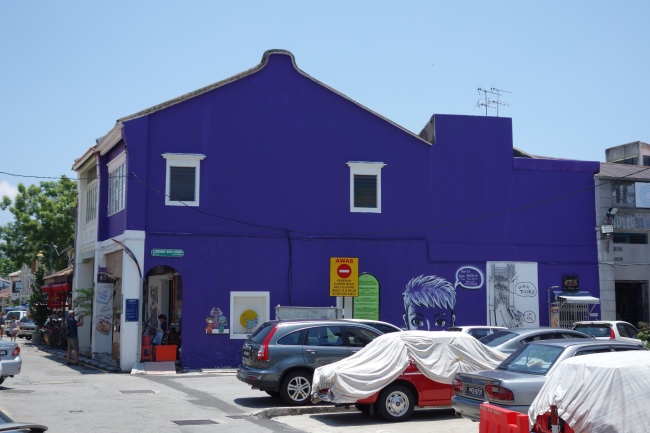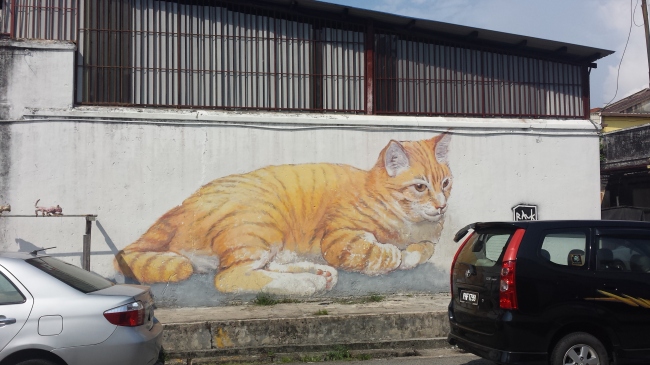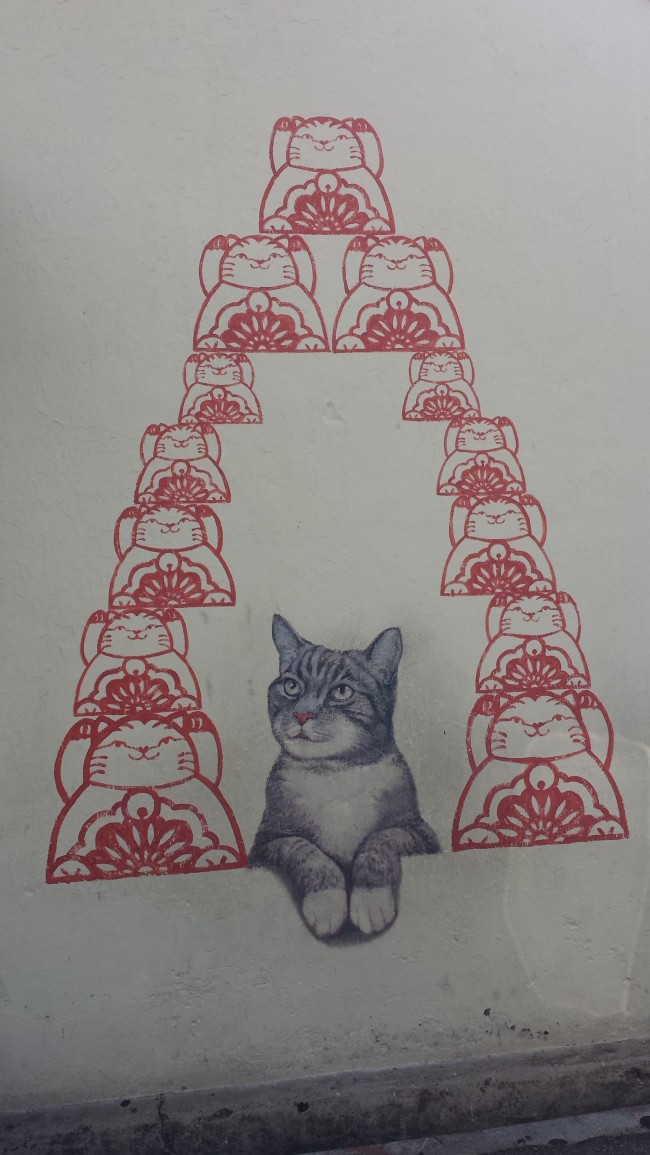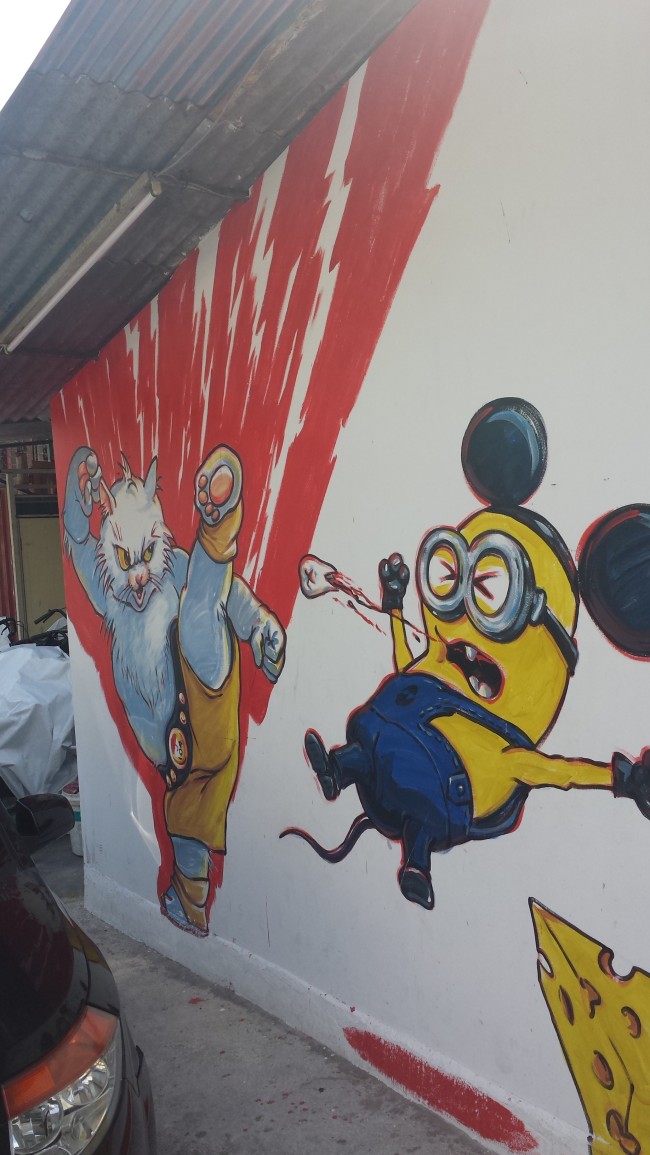Malaysia – Penang
by britishmisk
From Puduraya Bus Station we made our 5 hour journey to Penang in the north of the country. There are a few options available to get from KL to Penang, flying is probably the easiest, but given the fact KLIA is around an hour’s journey from the city centre and you have to get there a couple of hours beforehand, and with the hour’s flight time, there’s not that much time saved from the extra carbon emissions. There is also a train that runs from Singapore all the way through Malaysia to Butterworth, and from there you take a ferry to Penang island, but it takes a lot longer, the evening run is a sleeper train. There are a number of companies that operate buses from the station, all of them will try to ply you with promises so you’ll make use of their services. I searched online for a bus company that would take me to Komtar Tower near Georgetown, the colonial area of Penang Island we wanted to stay in. I confidently walked up to the counter for the bus company I wanted, ignoring all the touts who tried to take me for another western tourist, asked the guy for a ticket to Komtar, confirmed with him the bus did actually go to Komtar after he gave me a ticket that said ‘Sungai Ni[bong]’, the bus station in the middle of the island as opposed to the north, got on the bus and five hours later I found out it didn’t actually go to Komtar but to Sungai Nibong, go figure. So we ended up having to pay around £8 for a taxi to our hotel to Georgetown, not the worst thing that could happen on a holiday, but it was a reminder that not everything you read on the internet is true.
Georgetown in Penang is a UNESCO World Heritage Site, that adage in itself is usually enough reason for me to want to visit a place. In its heyday it was a thriving British trading post that acted as a melting pot of different cultures and peoples. Its best enjoyed, like many other cities that enjoy UNESCO privilege (such as Kyoto and Fes), by going for a wander and coming across old houses and places of worship perchance. As Penang is the one state in Malaysia that has a majority Chinese population the best buildings to see are the Chinese temples and clan houses, the most famous of which is Khoo Kongsi (pictured above), but there many others scattered around that are just as impressive on a smaller scale. One thing Penang takes pride in is the way its different ethnic and religious groups have got along with each other, and the fact that you have so many different temples. mosques, shrines and churches sprinkled around town, usually within close proximity to one another is testimony to that.
The first day and half we were in Penang were spent as I mentioned just wandering around the streets. Georgetown is not massive, so you can see a lot in a short period of time. The main things to see I felt, were Khoo Kongsi and the Kapitan Keling Mosque, originally built by Indians (I believe) but now used by Muslims of different ethnicities in Penang. You’ll find a number of Tamil Muslims praying in a syncretic mix of Shafi’i and Hanafi given that over the centuries followers of the two schools have mixed, though Shafi’i obviously being the more predominant in Malaysia. As you a wander around a bit more, especially by the time you get to Armenian Street, you’ll realise that the city has jumped on its UNESCO status in the last few years. There’s street art and hip cafes and shops opening up everywhere, usually next to run down dilapidated buildings waiting for the next businessman to turn it into the next trendy venue. It provides and interesting mix of old and new, and eventually I recognised as a Londoner that Georgetown was being Shoredified. Now I hate Shoreditch and the whole gentrification of East London by the hipster race, but in Georgetown the process seems to work. People who have been there for years, are still there, and they can still afford to live there (by the looks of it), prices (unless you go into one of the hip cafes/restaurants) are still cheap. There’s no unemployed arts students going around trying to makes their middle class accents sound street, there’s no guys with Philly beards in extra-skinny jeans (Malays struggle to even keep Sunnah beards given their genes, and secondly it’s too hot and humid for skinnies). And the street art is actually quite good, especially given that a lot of it involves cats:
So it had everything Shoreditch has to offer but better, and without the bits I hate. The only thing that still doesn’t work are the cafes. Most of them are style over substance, the one exception I found was a place called siTigun, a non-pretentious, rustic style coffee house that even had its own roastery. (I picked up some Sumatran beans which were great).
The main thing however that Penang is famous for after its history, is not its cool-hip scene, but its food, especially its hawker stall culture. Think what Lahore is to Pakistan, but with at least some form of health standard, and much less requirement for imodium. As a colleague who lived in China advised me, the tip to finding a good hawker stall is to find one that’s busy, that way you know the food is probably going to be good, and secondly they’re constantly going to be cooking their items fresh. To that end if you’re made to wait a little while for your food that’s usually a good sign. The only problem is that most businesses, including the hawker stalls, open from 10-5, when the day is at its hottest, you’ll still be able to find food in the evenings, but your choices will be limited slightly. The Red Garden however is a good choice to make for an evening meal. If you feel a little awkward about the whole hawker style system of ordering, you’re not alone, it can be quite confusing, even for locals, “Do we go up to the counter to place our order, or does someone come over?”, “Do we pay the guy who served us or do we have to go up to the counter this time?”, “Is this guy scamming me cos I’m tourist or have I just forgotten how to work addition”, all of these and more are valid questions when going out for a meal in Malaysia. The best thing to do is have a walk around and find a place that looks interesting, there’s usually someone who assists the cook by helping out customers, look out for this person and ask them any questions you have, most places will be halal but some of the Chinese run establishments won’t be as they use pork lard in some dishes, they’ll tell you if this is the case. Once you’ve made your order pull up a plastic chair on a dirty table and don’t expect Parisian style dining, it’ll be hot, busy, noisy, you’ll still be a little confused about the whole system, but the food is going to be great. Once the person has served you they’ll take payment there and then, there’s usually a separate business that handles drinks, and they will is most cases come over to you quite soon after you sit down. Personal tip is call them over again once you’ve finished your meal and order a teh tarik (Malaysian style tea) for afters, it’s one of the best hot drinks ever. To get an idea of what to try we picked up a food map from the hotel which had a list of dishes Penang is famous for, and some of the stalls that produce the best versions of said dishes. See if you can find a copy, but don’t worry too much about going for the stalls listed, just look out for a busy one serving any of the dishes you’re interested in.
On our final full day in Penang we visited Kek Lok Si, the largest Buddhist temple in Malaysia, situated in the middle of the island up the hill. From there we visited the national park in Batu Ferringhi. Batu Ferringhi is the beach resort side of town (you’ll see a lot of Gulf Arabs on honeymoon, dudes dressed in t-shirts and shorts while wifey stays in niqab, go figure). The national park is the smallest in Malaysia, it spreads along the coast at the north-western tip of the island and there’s a beach for most of it. Unfortunately we couldn’t spend too long there as we had hired a driver for the day, but the main destination in the park for most people is Turtle Beach. Despite its small size there are a few trails of varying lengths you can go on. From there we made a brief stop at Coffee Tree a popular place that lots of taxi drivers will recommend to you, I assume they make some sort of commission as you’re given a sticker on your shirt as you walk in with your driver, but the prices are fixed and our driver didn’t push a sell on us so it was no loss on us. They sell loads of different flavours of coffee, mostly instant, and weird and wonderful chocolates, it’s a little pricey but a decent place to pick up gifts for back home. From there we made our way to the temple of the sleeping Buddha, which is built in a Thai style, immediately across the road on the other side is a Burmese style temple with a standing Buddha. In the evening we took a bus back to Batu Ferringhi to check out the night market. Though most of it is cheap wares from China, you can pick up some decent pieces, make sure you take your haggling skills with you.
And so ended our trip in Penang. Looking up a list of places to visit in Malaysia, Penang is always on there, and rightly so. If you consider going to Malaysia I would highly recommend adding Penang to the list. From there we made our way to Kuching in Borneo, and that will God willing follow in the next post.




